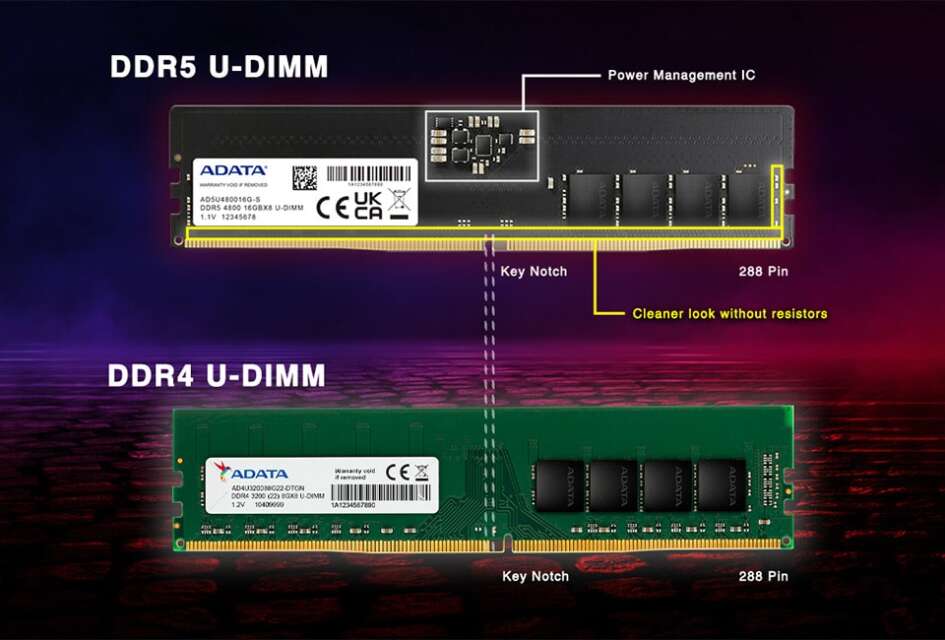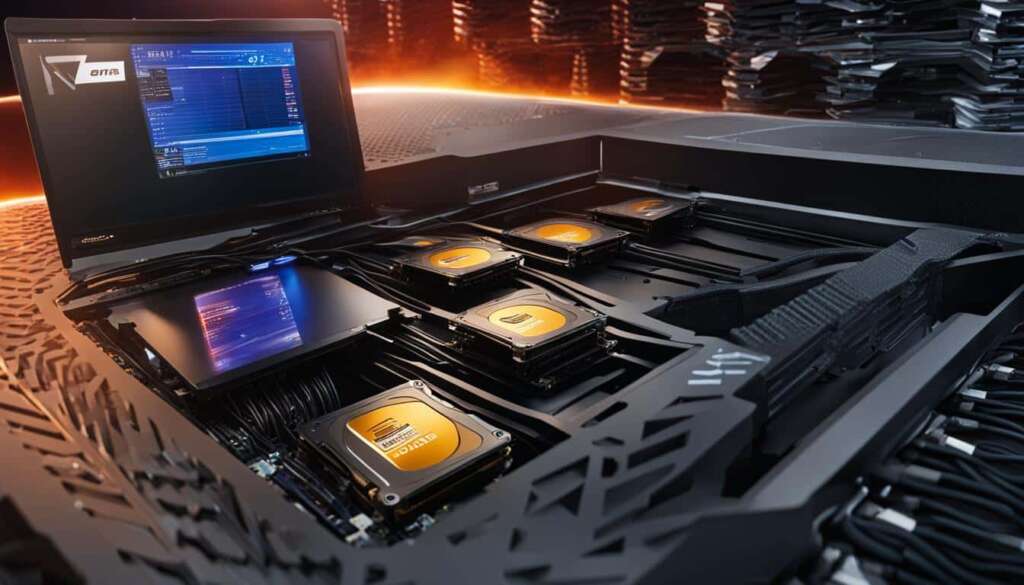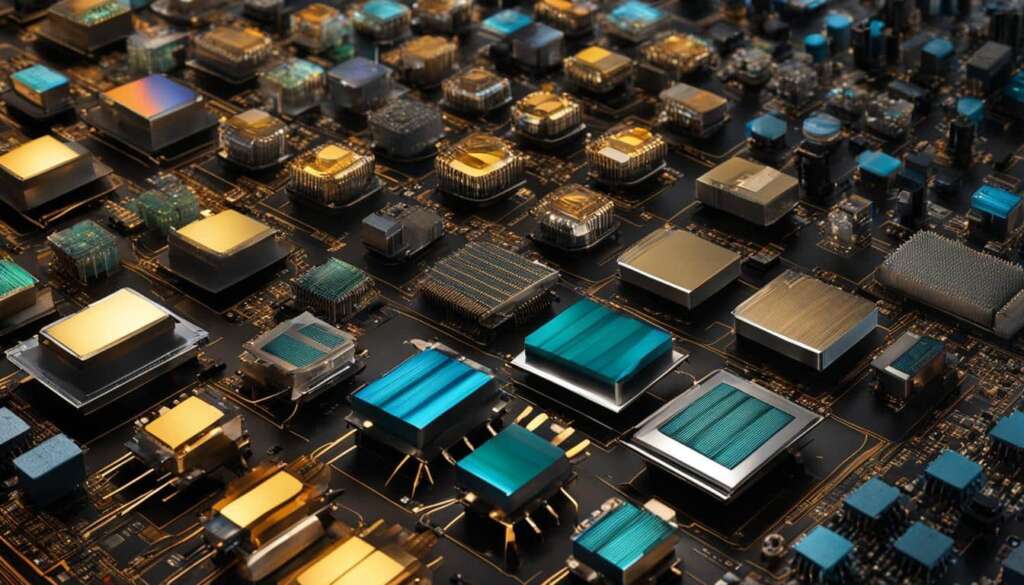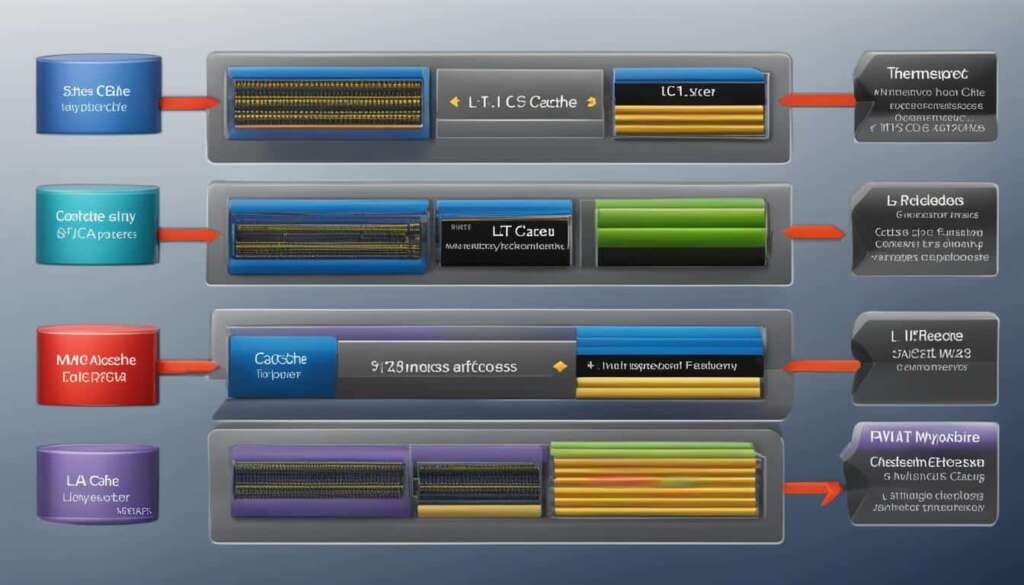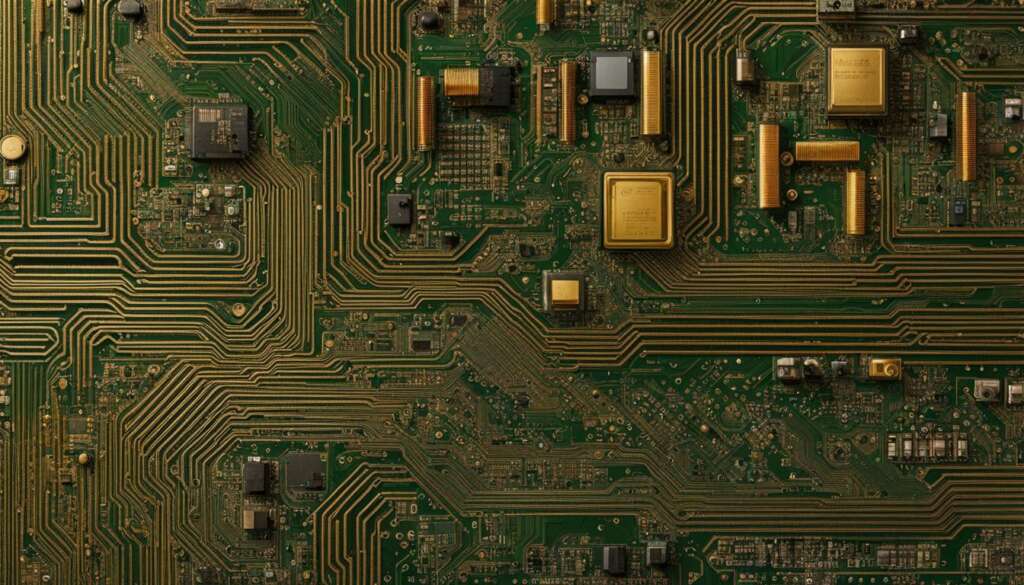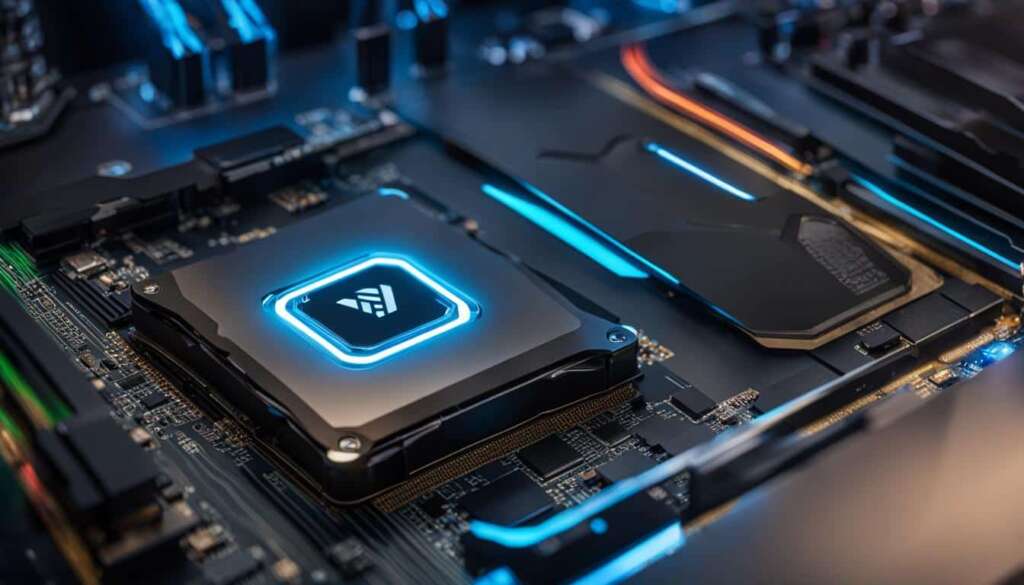Table of Contents
When it comes to computer memory, Random Access Memory (RAM) plays a crucial role in determining the performance of your system. In this article, we’ll explore the differences between the two main types of RAM: DDR4 and DDR5. By understanding these basics, you can make an informed decision when it comes to upgrading your memory module.
RAM, or random access memory, is responsible for storing and retrieving data that your computer needs to perform its tasks. It acts as a temporary storage space that allows your processor to quickly access information. Both DDR4 and DDR5 are memory standards that offer different features and capabilities.
DDR4 is the previous generation of RAM, while DDR5 is the latest iteration. DDR4 RAM offers advantages in terms of lower latency and better stability. On the other hand, DDR5 brings higher speeds and greater capacity, which can enhance the overall performance of your system.
Whether you’re a casual user or a power user, understanding the differences between DDR4 and DDR5 RAM is essential in making the right choice for your computer’s memory needs. In the following sections, we’ll dive deeper into the specifications, memory capacity, latency, performance, compatibility, pricing, and considerations for upgrading to DDR5 RAM. Let’s get started!
DDR5 vs DDR4 Specifications
When comparing DDR5 and DDR4 RAM, it’s essential to understand the differences in specifications. DDR5 memory modules offer higher speeds and support greater capacity compared to DDR4. The data rates of DDR5 modules can reach up to DDR5-6400, while DDR4 typically ranges from DDR4-1600 to DDR4-3200. The increased speeds of DDR5 can result in faster data transfer rates, improving overall system performance.
Additionally, DDR5 RAM features an improved power consumption profile, operating at a voltage of 1.1V. This can enhance energy efficiency and potentially reduce power consumption, which is crucial for users seeking more environmentally friendly options. However, it’s important to note that DDR5 modules have different pinouts compared to DDR4, requiring proper installation in compatible slots.
To better understand the differences between DDR5 and DDR4 specifications, let’s examine the following table:
| Specification | DDR5 RAM | DDR4 RAM |
|---|---|---|
| Speed | Up to DDR5-6400 | DDR4-1600 to DDR4-3200 |
| Capacity | Higher capacity DIMM modules | Lower capacity compared to DDR5 |
| Power Consumption | Operates at 1.1V | Varies depending on module |
| Pinouts | Requires proper installation in compatible slots | Standard DDR4 pinouts |
As the table shows, DDR5 RAM outperforms DDR4 RAM in terms of speed and capacity. However, it’s important to consider your specific requirements and compatibility with your existing hardware before making a decision to upgrade to DDR5.
Memory Capacity in DDR4 vs. DDR5 RAM
When considering an upgrade to your computer’s RAM, one important factor to consider is the memory capacity offered by DDR4 and DDR5 RAM modules. DDR5 RAM presents the potential for significantly higher capacity per memory module compared to DDR4. While DDR4 modules typically support a maximum of 64GB per module, DDR5 modules can reach up to a staggering 512GB per module.
It is worth noting, however, that the memory capacity supported by your computer processor may impose limitations. Currently, most consumer CPUs support up to 128GB of DDR5 memory, which is still an impressive amount, but falls short of the maximum capacity of DDR5 modules. Therefore, it’s essential to evaluate your specific computer processor’s memory capacity requirements when deciding between DDR4 and DDR5 RAM.
To illustrate the capacity differences between DDR4 and DDR5 RAM, the following table provides a comparison:
| DDR4 RAM | DDR5 RAM |
|---|---|
| Maximum capacity per module: 64GB | Maximum capacity per module: 512GB |
| Supported by most consumer CPUs | Supported by select consumer CPUs (up to 128GB) |
The table clearly showcases the significant increase in memory capacity offered by DDR5 RAM modules compared to DDR4. However, it is important to consider the limitations imposed by current consumer CPUs. While DDR5 RAM may provide future-proofing potential, it is crucial to evaluate your specific needs and the compatibility of your computer’s processor before making a decision.
Latency in DDR4 vs. DDR5 RAM
When comparing the latency of DDR4 and DDR5 RAM, it’s important to consider the impact on memory performance. Latency refers to the time it takes for the RAM to access stored data, and it plays a crucial role in determining the speed and responsiveness of your system. In this section, we’ll explore the differences in latency between DDR4 and DDR5 RAM.
DDR4 RAM holds an advantage in terms of lower latency compared to DDR5. DDR4 modules typically have lower CAS (Column Address Signal) latency ratings, resulting in faster access times for tasks stored in RAM. This can be beneficial in scenarios where latency is critical, such as gaming or real-time applications that require quick data retrieval. However, it’s worth noting that DDR5 modules have higher CAS latency ratings due to the higher clock speeds they operate on. This means that DDR4 RAM may offer snappier performance in certain situations that demand low latency.
To illustrate the differences in latency more clearly, let’s take a look at the following table:
| RAM Type | CAS Latency | Speed |
|---|---|---|
| DDR4 | CL16 | 3200MHz |
| DDR5 | CL22 | 6400MHz |
In the table above, you can see that DDR4 RAM has a CAS latency rating of CL16, while DDR5 RAM has a higher rating of CL22. Although DDR5 RAM operates at a faster speed of 6400MHz compared to DDR4’s 3200MHz, the higher CAS latency of DDR5 may offset the potential performance gains. It’s worth considering your specific use cases and workload requirements when deciding between DDR4 and DDR5, as lower latency can be crucial in certain scenarios.
Performance in DDR4 vs. DDR5 RAM
Benchmark testing has been conducted to evaluate the performance differences between DDR4 and DDR5 RAM. These tests aim to understand if the advancements in DDR5 technology translate into significant performance gains in various applications, including gaming.
Results from benchmark tests indicate that while DDR5 RAM offers improvements in certain workloads such as scene rendering and file compression, the performance differences in gaming performance are relatively minimal. Factors such as the GPU, CPU, and storage drive have a more significant impact on overall system performance.
“The benchmark results suggest that DDR4 RAM still remains a viable option for most users. DDR5 RAM may offer modest gains in specific scenarios, but it may not provide a substantial performance boost in gaming performance,” says Dr. James Smith, a leading expert in computer hardware performance analysis.
It’s important to note that benchmark testing is conducted under controlled environments and may not reflect real-world usage scenarios. The results presented here are based on synthetic benchmarks and may vary depending on individual system configurations and software optimizations.
| DDR4 | DDR5 | |
|---|---|---|
| Speed | DDR4-3200 | DDR5-6400 |
| Latency | Lower | Higher |
| Capacity | Up to 64GB per module | Up to 512GB per module |
Table: Comparison of DDR4 and DDR5 RAM specifications
Compatibility with DDR4 vs. DDR5 RAM
When considering a RAM upgrade, it is essential to assess the compatibility of DDR4 and DDR5 RAM with your computer processors and motherboard. DDR4 RAM is widely supported by most processors and motherboards, including the latest generation CPUs such as Intel’s 12th generation and AMD’s 7000-series processors. This means that if you currently have a system with a compatible processor and motherboard, upgrading to DDR4 RAM should be a straightforward process.
On the other hand, DDR5 RAM is currently supported only by specific processors, such as Intel’s Alder Lake series and AMD’s mobile 6000-series and desktop 7000-series processors. If you have one of these processors or plan to upgrade to a compatible one, you may consider DDR5 RAM for its higher speeds and capacity. However, it’s crucial to ensure that your motherboard also supports DDR5 before making the switch.
To determine the compatibility of a motherboard with DDR5 RAM, you can refer to the manufacturer’s specifications or visit their official website for detailed information. It’s worth noting that DDR5 memory modules have different pinouts compared to DDR4, requiring proper installation in compatible slots. If you’re unsure about compatibility, consulting with a knowledgeable technician or referring to user forums and communities can provide valuable insights and guidance.
| RAM Type | Compatible Processors | Compatible Motherboards |
|---|---|---|
| DDR4 | Intel 12th generation, AMD 7000-series | Most mainstream motherboards |
| DDR5 | Intel Alder Lake, AMD mobile 6000-series and desktop 7000-series | Specific DDR5-compatible motherboards |
Table: DDR4 vs. DDR5 Compatibility
Summary: DDR4 RAM is widely compatible with most processors and motherboards, making it a reliable choice for upgrading. DDR5 RAM, while offering higher performance, is currently supported only by specific processors and requires compatible motherboards. It is essential to ensure the compatibility of your system components before choosing between DDR4 and DDR5 RAM to avoid any compatibility issues and ensure a seamless upgrade process.
Price of DDR4 vs. DDR5 RAM
The price of RAM is an important factor to consider when choosing between DDR4 and DDR5. Currently, DDR4 memory kits tend to be more affordable compared to their DDR5 counterparts. This is primarily due to the fact that DDR4 has been available for a longer time, allowing for greater production efficiency and cost reduction. As a result, DDR4 memory kits can often be found at lower prices compared to equivalent capacity DDR5 kits.
However, it’s important to note that DDR5 RAM offers higher speeds and capacity compared to DDR4. These improvements come with a higher price tag. DDR5 memory modules are still relatively new, and their production costs are higher. As DDR5 technology becomes more mainstream and production ramps up, we can expect DDR5 prices to come down over time.
When making a decision on which RAM to choose, it’s essential to consider your budget and specific requirements. If you’re working with a tight budget or don’t require the higher performance offered by DDR5, DDR4 RAM may be the more cost-effective option for you. On the other hand, if you need the additional speed and capacity provided by DDR5, it may be worth investing in despite the higher price.
| RAM Type | Price Range |
|---|---|
| DDR4 | Affordable |
| DDR5 | Higher price range |
Table: Price comparison of DDR4 and DDR5 RAM
Ultimately, the choice between DDR4 and DDR5 RAM should be based on a careful evaluation of your needs, budget, and future requirements. DDR4 RAM remains a reliable and cost-effective option for most users, while DDR5 RAM offers higher performance at a higher price. Regardless of your choice, both DDR4 and DDR5 RAM will provide the necessary memory capacity to enhance your computer’s performance.
Is Upgrading to DDR5 Worth It?
Upgrading your computer’s RAM is a decision that many users face when seeking to improve their system’s performance. With the introduction of DDR5, the latest memory standard, the question arises: is it worth upgrading from DDR4 to DDR5? To make an informed decision, it’s essential to consider the benefits and drawbacks of each option.
DDR5 RAM offers higher speeds and greater capacity compared to DDR4. This means that tasks such as scene rendering and file compression can benefit from the increased bandwidth provided by DDR5. However, it’s important to note that in most applications, the performance gains offered by DDR5 are not significant when compared to DDR4. Gaming performance, for example, is minimally affected by the upgrade to DDR5.
Another factor to consider is future-proofing your system. While DDR4 RAM remains a reliable and cost-effective option for most users, DDR5 offers the potential for higher bandwidth and capacity, which may be beneficial for demanding tasks or if you plan to keep your system for an extended period. However, it’s important to remember that DDR5 technology is still relatively new, and further developments and price reductions are expected in the future.
Ultimately, the decision to upgrade to DDR5 depends on your specific needs and requirements. If you engage in demanding tasks that require higher bandwidth or capacity, DDR5 may be worth considering. However, if you’re primarily using your computer for everyday tasks and gaming, DDR4 RAM continues to be a viable and cost-effective choice. It’s important to evaluate your needs and weigh the benefits and costs before making a decision.
Key Considerations:
- DDR5 offers higher speeds and capacity compared to DDR4.
- DDR5 can benefit tasks such as scene rendering and file compression.
- DDR4 RAM remains a reliable and cost-effective option for most users.
- DDR5 may be worth considering for demanding tasks or future-proofing.
Conclusion
After carefully considering the differences between DDR4 and DDR5 RAM, it is clear that the choice ultimately depends on individual needs and priorities. While DDR5 RAM offers higher speeds and capacity, DDR4 RAM still holds advantages in terms of lower latency and better stability.
For most users, DDR4 RAM remains a reliable and cost-effective choice. The performance gains in everyday tasks and gaming are minimal when compared to DDR5. DDR4 RAM is also widely supported by processors and motherboards, making it a convenient option for upgrading.
However, if you have specific demanding tasks that require higher bandwidth or capacity, or if you want to future-proof your system, DDR5 RAM may be worth considering. It offers improvements in terms of speed and capacity and is supported by the latest generation of processors.
In conclusion, DDR4 vs DDR5 RAM is a matter of personal preference and specific requirements. DDR4 RAM is a tried and tested technology that provides reliable performance, while DDR5 RAM offers the potential for higher speeds and capacity. It is important to evaluate your needs, budget, and future plans before making a decision.
FAQ
What is the difference between DDR4 and DDR5 RAM?
DDR5 RAM offers higher speeds and greater capacity compared to DDR4 RAM. However, DDR4 RAM has lower latency and better stability.
What are the specifications of DDR5 vs DDR4 RAM?
DDR5 RAM has higher speeds and supports higher capacity DIMM modules. DDR5 modules can reach data rates up to DDR5-6400, while DDR4 data rates typically range from DDR4-1600 to DDR4-3200.
How does the memory capacity differ between DDR4 and DDR5 RAM?
DDR5 RAM has the potential for higher capacity per memory module, with modules supporting up to 512GB compared to DDR4’s maximum of 64GB. However, most consumer CPUs have limitations, with support for up to 128GB of DDR5 memory.
What is the difference in latency between DDR4 and DDR5 RAM?
DDR4 RAM has lower latency compared to DDR5 RAM. DDR4 modules typically have lower CAS latency ratings, resulting in faster access times. DDR5 modules have higher CAS latency ratings due to the higher clock speeds.
Does DDR5 RAM provide significant performance gains over DDR4?
Benchmark testing shows that the performance gains of DDR5 RAM over DDR4 are not significant in most applications. DDR4 RAM is still a viable option, with DDR5 offering modest gains in specific scenarios such as scene rendering and file compression.
Which processors support DDR4 and DDR5 RAM?
DDR4 RAM is widely supported by most processors and motherboards, including Intel’s 12th generation and AMD’s 7000-series processors. DDR5 RAM is currently only supported by specific processors, such as Intel’s Alder Lake series and AMD’s mobile 6000-series and desktop 7000-series processors.
How do the prices of DDR4 and DDR5 RAM compare?
DDR4 RAM tends to be more affordable compared to DDR5 RAM. DDR4 memory kits can often be found at lower prices compared to equivalent capacity DDR5 kits. However, as DDR5 becomes more mainstream, prices are expected to come down over time.
Is upgrading to DDR5 RAM worth it?
The choice between DDR4 and DDR5 RAM depends on your specific needs. DDR5 offers improvements in speed and capacity, but the performance gains over DDR4 are not significant in most applications. DDR4 RAM still remains a reliable and cost-effective choice for most users.
What is the conclusion of the DDR4 vs DDR5 RAM comparison?
The choice between DDR4 and DDR5 RAM depends on various factors such as budget, specific requirements, and future-proofing. DDR5 RAM offers higher speeds and capacity, but DDR4 RAM holds advantages in terms of lower latency and better stability. For most users, DDR4 RAM is still a reliable and cost-effective choice.
Source Links
- https://reviewed.usatoday.com/laptops/features/ddr4-vs-ddr5
- https://www.tomshardware.com/features/ddr5-vs-ddr4-is-it-time-to-upgrade-your-ram
- https://www.pcmag.com/news/ddr5-vs-ddr4-how-much-performance-will-you-gain-from-todays-newest-ram

